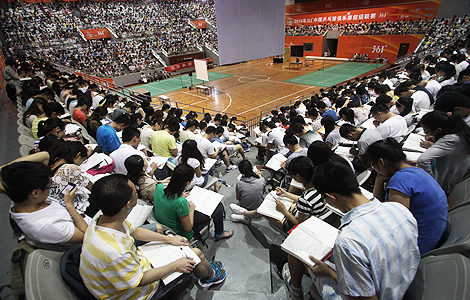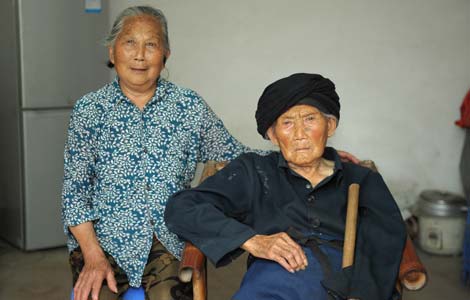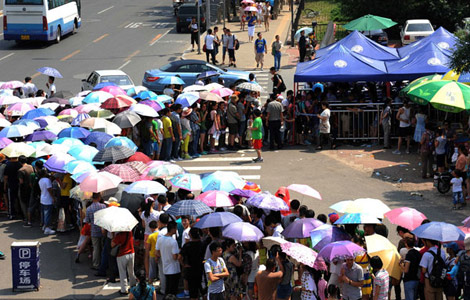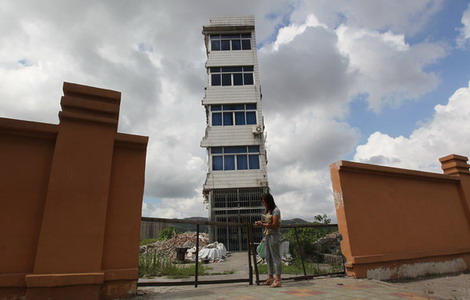

Lack of research and high price of drugs add to suffering, reports Yang Wanli in Beijing.
Zhao Weijia is 15, lives in Beijing and was diagnosed with Gaucher disease when he was 6. The disease, the result of a missing enzyme, is estimated to afflict one in every 100,000-400,000 people worldwide. In China, medical treatment is available for just 1 percent of the people who fall victim to rare diseases. Zhao, who receives medication for free, is in that 1 percent.
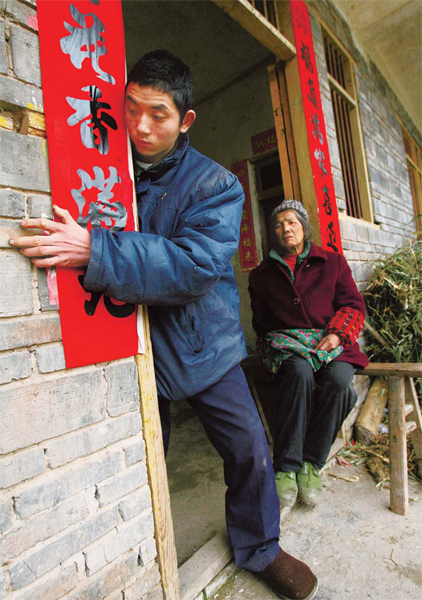 |
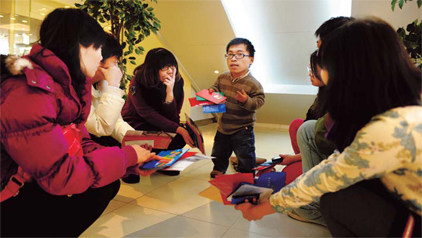 Top: Liu Kaiqian needs support to move even one step outside his house because of amyotrophic lateral sclerosis, also called Lou Gehrig’s disease. He is one of six in his family who have the rare degenerative disease, which aff ects nerve cells in the brain and spinal cord. Liu’s family, including his grandmother, in the doorway, lives in Liangping county in Chongqing in Southwest China. Above: Huang Rufang was born with osteogenesis imperfecta, sometimes called brittle bone disease, because the rare condition interferes with the production of strong bones. He was photographed in December briefing volunteers about a charity sale in Beijing that aimed to raise awareness of the disease. [Photo provided to China Daily] |
Huang Huan lives in Beijing, is 28 and has known for five years that she has pulmonary hypertension. There's no cure. Drugs can alleviate the symptoms but, after two years of paying 10,000-30,000 yuan a month ($1,520-$4,570), she can no longer afford them. She signed up for a medical trial of an experimental drug because it's free.
These are just three of the estimated 15.6 million people in China who suffer a disease or condition so rare that diagnosis itself is a feat. Treatment, if there is any, is almost always prohibitively expensive.
Their ailments are called rare diseases for obvious reasons, although the precise definition varies. The treatments that patients and scientists seek are called orphan drugs: they are for such a narrow segment of the population that there's no hope of recovering the cost of developing them.
The 15.6 million estimate for China is a ballpark figure at best, because China has not defined "rare disease" and has no reliable data on how many sufferers there are in the country.
In the United States, any disease or condition that afflicts fewer than 200,000 people meets the definition in the Rare Diseases Act of 2002. The National Institutes of Health estimates there are about 7,000 rare diseases in the US, 80 percent of them with genetic origins.
The World Health Organization sets the limit at 0.65 to 1 per 1,000 people.
WHO's formula would put the rate at up to 1.3 million people per rare disease on China's mainland. Lacking their own data, mainland doctors have their own working numbers of about 6,000 rare diseases at a rate of 1 per 500,000.
But if you or a loved one has such a disease, the bigger numbers don't matter.
'Many unknowns'
"People never heard about 'rare disease' 10 years ago and it is even unfamiliar to some doctors now," said Xu Kaifeng, a physician at Peking Union Medical College Hospital. "We still can't answer many unknowns, including the definition, the number of patients and treatment."
Xu said that most rare disease patients experience misdiagnosis or missed diagnosis because many doctors have never seen such cases before. That's what happened to Zhang Yafei. Symptoms of Fabry disease emerged when he was 4 but went unexplained for 25 years, and then only because he recognized his symptoms on a television show.
"Few medical institutions are engaged in the research of rare diseases, and this means patients do not get timely diagnosis and treatment," said Huang Ziheng, director of the Rare Disease Office of China Charity Foundation. "There are also no preferential policies to encourage domestic pharmaceutical companies to develop new drugs treating rare diseases."
In the US, the Orphan Drug Act of 1983 set up incentives and an accelerated timeline for approval of drugs for rare diseases. "The development of an average new medicine can take 10-15 years and cost more than $1.3 billion," the Pharmaceutical Research and Manufacturers of America said in February.
Only one in 6,155 drugs in development make it to the market; just one-third of them make a profit for the companies that developed them. And those figures are for the average medicine, not one with a tiny patient pool.
"Rare disease drugs are among those sold at a loss," Huang said, although she added that some foreign companies continue to produce orphan drugs for charity. "In that case," she said, "government should give a hand."
At 2009's two sessions of the National People's Congress (NPC) and the Chinese People's Political Consultative Conference, 30 NPC deputies proposed that medical insurance give preference to sufferers of rare diseases.
The State Food and Drug Administration (FDA) released a regulation in 2009 for registering new drugs, which opened a fast track for some rare diseases. Registering drugs for import involves extensive documentation about the drug company and foreign drug trials, plus clinical trials in China, and the process takes about a year.
"Clinical tests slow the registration," Huang said. Among all imported orphan drugs, she said, only Cerezyme for Gaucher disease - the intravenous drug provided free to young Zhao Weijia - won approval from China's FDA.
"The cost for clinical tests of rare disease drugs is too much compared with ordinary drugs," Huang said. "If we need to test Cerezyme on at least 200 people, the company has to spend 20 million yuan."
Finding sufficient test subjects is a problem. "Some rare diseases have fewer than 100 patients on record nationwide," said Xu, the Peking Union doctor.
Support for patients
The Rare Disease Office of China Charity Foundation was set up in 2008 with a grant of 2 million yuan from Genzyme, the US pharmaceutical company that developed Cerezyme. Genzyme had cooperated with Project HOPE, an international healthcare organization founded in the US, in bringing Cerezyme to patients in 1999.
The grant to the office covers dispensing the free drugs and work to raise awareness of rare diseases. Some rare diseases can be detected in pregnancy and can be treated or even prevented at an early stage.
The financial burden on patients can be heavy.
"Rare disease patients can only get help from welfare organizations or patient groups," Huang said. She said at least 10 disease-specific patient groups operate nationwide and seven other organizations help rare disease patients, including Red Cross Society of China and China Soong Ching Ling Foundation.
"We need more support from the government, especially a regulation that can help the patients for life," Huang said.
Some attempts have been made worldwide, said Wang Chenguang, vice-president of Tsinghua University's law school. Wang researched policies and laws on rare diseases for three years.
In South Korea, which is estimated to have fewer than 20,000 rare disease patients, the government pays two-thirds of treatment costs, Wang said. In Italy, a rare disease fund was established in 2007 that provided 300 million euros ($421.5 million) for treatment.
Help at home
Shanghai is attempting to develop a fund and a plan to cover treatment for 12 rare diseases under a program similar to standard medical insurance. It is believed to be the only city on China's mainland involved in such an effort.
The program is sponsored by Shanghai Civil Affairs Bureau, Shanghai Red Cross and the Health Bureau, but how much money the fund can get, and how it will do, is still being worked out.
Li Dingguo is president of Shanghai Rare Disease Society, which is trying to gain government support for the program. The society, comprising 28 medical professionals, was founded Feb 28.
Insurance is the first step, Li said, and then medical research. "Epidemiological investigation was never carried out nationwide, which stops us from knowing how many such patients need help in our country." Li said, for example, that many rare diseases are tied to genetic problems but are not part of standard hospital tests for birth defects.
For patients already afflicted with rare diseases, having their medications covered by insurance is their only hope.
An employee in the press office of the Ministry of Labor and Social Security said that including rare diseases in the national medical insurance program is not on the agenda. One reason: China lacks a clear definition of what constitutes a rare disease.
The employee declined to be named and would say no more because an interview had not been approved.


